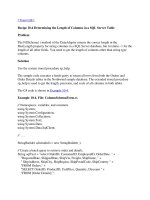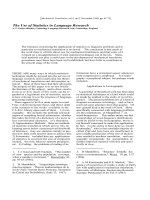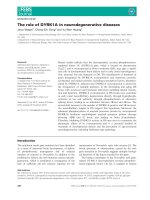The Order of Adjectives in a Series docx
Bạn đang xem bản rút gọn của tài liệu. Xem và tải ngay bản đầy đủ của tài liệu tại đây (14.3 KB, 2 trang )
The Order of Adjectives in a Series
It would take a linguistic philosopher to explain why we say "little brown house" and not "brown little
house" or why we say "red Italian sports car" and not "Italian red sports car." The order in which adjectives
in a series sort themselves out is perplexing for people learning English as a second language. Most other
languages dictate a similar order, but not necessarily the same order. It takes a lot of practice with a
language before this order becomes instinctive, because the order often seems quite arbitrary (if not
downright capricious). There is, however, a pattern. You will find many exceptions to the pattern in the
table below, but it is definitely important to learn the pattern of adjective order if it is not part of what you
naturally bring to the language.
The categories in the following table can be described as follows:
THE ROYAL ORDER OF ADJECTIVES
Determiner >Observation >size >shape >age >colour >Origin >Material
>Qualifier >NOUN
Determiners — articles and other limiters.
See Determiners Observation — postdeterminers and limiter adjectives (e.g., a real hero, a perfect idiot)
and adjectives subject to subjective measure (e.g., beautiful, interesting)
Size and Shape — adjectives subject to objective measure (e.g., wealthy, large, round)
Age — adjectives denoting age (e.g., young, old, new, ancient)
Color — adjectives denoting color (e.g., red, black, pale)
Origin — denominal adjectives denoting source of noun (e.g., French, American, Canadian)
Material — denominal adjectives denoting what something is made of (e.g., woolen, metallic, wooden)
Qualifier — final limiter, often regarded as part of the noun (e.g., rocking chair, hunting cabin, passenger
car, book cover)
(Posted by David L. UK)
Word Order for Adjectives Exercise(with answers)
OPINION
CONDITION
SIZE
AGE
COLOUR
ORIGIN
MATERIAL
NOUN
1
My smelly old maths teacher
my
teacher
old
maths
smelly
2
a small old black Turkish box
black
small
box
Turkish
a
old
3
a friendly fat young man
man
a fat
friendly
young
4
our boring tall headmaster
tall
our
headmaster
boring
5
a long dark wooden table
wooden
dark
a
table
long
6
a beautiful old Spanish city
city
a
Spanish
beautiful
old
7
our nice French arts teacher
arts
nice
teacher
our
French
8
a perfect new system
new
a
perfect
system
9
a fantastic 18th century Scottish castle
18th century
a
Scottish
fantastic
castle
10
a horrible greedy businessman
a
business
horrible
greedy
11
a big old brown bear
a
big
old
brown
bear
12
a self-righteous middle-class student
student
self-righteous
a
middle-class
13
a nasty spoilt little boy
spoilt
boy
nasty
a
little
14
a gorgeous black-haired green-eyed girl
green-eyed
gorgeous
black-haired
a
girl









